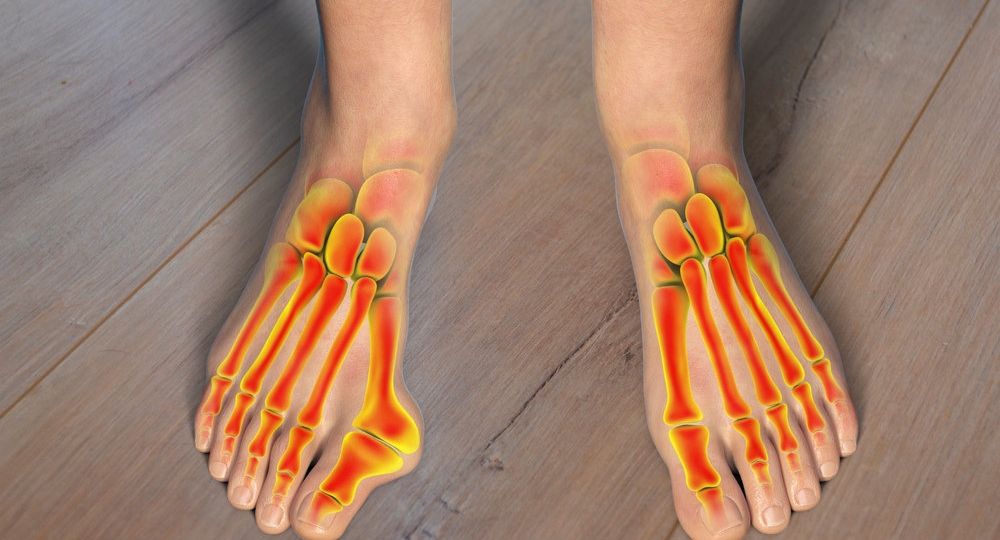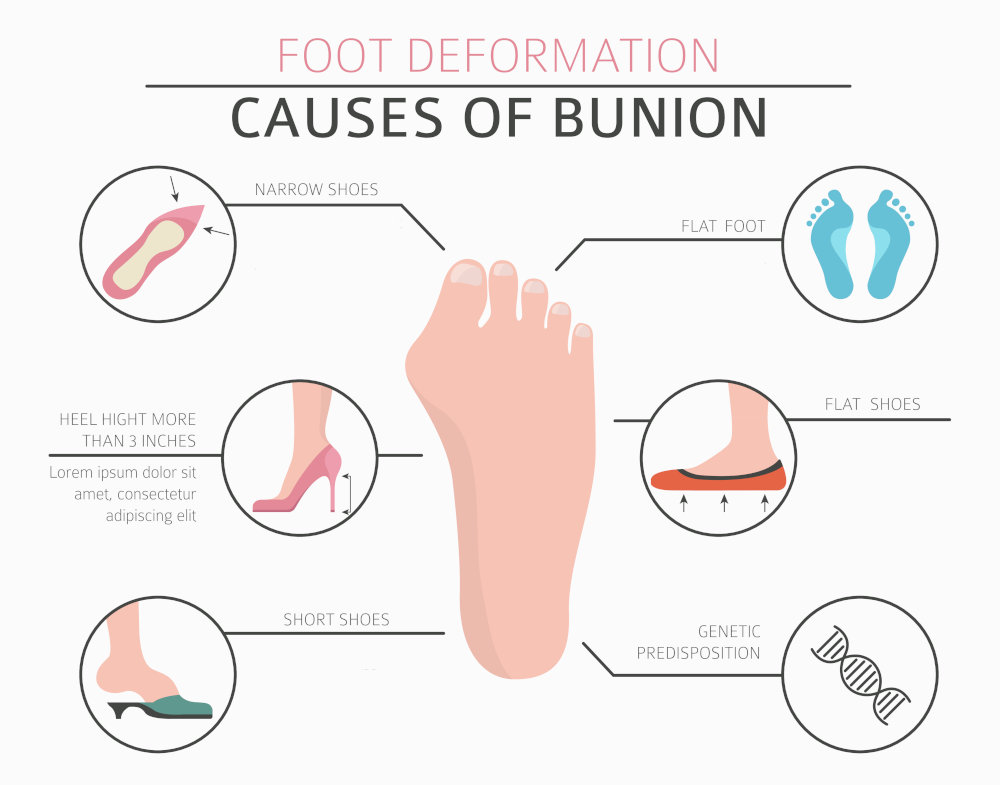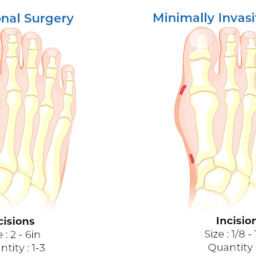
Bunions are a common foot problem that affects millions of people worldwide. They occur when the joint at the base of your big toe becomes enlarged and protrudes outward, causing pain and discomfort. If left untreated, bunions can worsen over time and lead to other foot problems. However, there are several ways of correcting bunions without surgery .
Non-surgical bunion foot pain treatment involves several methods aimed at relieving the pain and discomfort associated with bunions. This type of treatment can include taking anti-inflammatory drugs, maintaining a healthy weight, wearing comfortable shoes with a wide toe box, using gel-filled pads, toe spacers, bunion splints, and shoe inserts. These treatments help to reduce pressure on the bunion and realign the toes, which can provide long-term relief from bunion pain. Non-surgical bunion treatment is an effective option for individuals with mild to moderate bunions, and it can help prevent the need for surgery in the future.
How Can You Get Bunions Corrected With Splints
Bunion splints are designed to help realign the toes and reduce bunion pain. They are usually worn at night and work by pulling the big toe away from the other toes, which helps to prevent the bunion from getting worse. To correct a bunion splint, you should first ensure that it is properly sized and fitted to your foot. Next, adjust the straps on the splint to provide a comfortable but snug fit. Be sure to follow the manufacturer’s instructions for adjusting the splint, and do not overtighten it as this can cause discomfort or even injury. Regularly checking and adjusting your bunion splint can help ensure that it is providing the maximum benefit to your foot. Sometimes a person will choose this option for bunions treatment without surgery.
Alternative Treatment to Bunions
While surgical intervention is often necessary for severe cases, there are several alternative treatments available that can help alleviate pain and slow the progression of bunions. Additionally, dietary changes, such as reducing inflammation-causing foods, can help reduce pain and inflammation associated with bunions. Alternative treatments for bunions are an effective option for individuals who prefer non-invasive approaches to treating their foot condition or those who want to complement traditional medical treatments.
- Anti-inflammatory drugs – One of the simplest and most effective ways to treat bunion pain is to take anti-inflammatory drugs like ibuprofen or naproxen. These drugs can help reduce swelling and relieve pain in the toe joint.
- Maintain a healthy weight – Excess weight can put pressure on your toes and exacerbate bunion pain. Therefore, maintaining a healthy weight can help alleviate bunion pain.
- Comfortable shoes – Wearing comfortable shoes with a wide toe box can help reduce the pressure on your toes and provide relief from bunion pain. Shoes with arch support can also help improve foot alignment and reduce bunion pain.
- Gel-filled pads – Gel-filled pads can provide cushioning and pain relief for bunions. They can be placed inside shoes to help reduce pressure on the bunion.
- Toe spacers – Toe spacers can help reduce the pressure on the bunion and realign the toes. They can be worn during the day or at night to help alleviate bunion pain.
- Bunion splints – Bunion splints can help realign the toes and reduce bunion pain. They are usually worn at night and can provide long-term relief from bunion pain.
- Shoe inserts – Shoe inserts can help provide support and reduce the pressure on the bunion. They can be custom-made or purchased off the shelf and are designed to fit inside your shoes.
When To See a Doctor About Your Bunions?
One indication that it is time to see a doctor for bunion treatment is if the pain is severe and interfering with your daily activities. If the bunion is causing you to change your gait or avoid certain activities, it is time to consult with a healthcare professional. Additionally, if you are experiencing redness, swelling, or warmth in the affected area, it may be a sign of infection and require medical attention.
Another reason to see a doctor for bunion treatment is if the bunion is getting worse over time. While non-surgical treatments can provide relief, they may not be enough to prevent the bunion from getting worse. In some cases, surgery may be necessary to correct the problem and prevent further damage to the foot.
If you have diabetes or other medical conditions that affect circulation or nerve function in your feet, it is particularly important to seek medical attention for bunion treatment. Bunions can increase the risk of foot complications in people with diabetes, so it is important to have them treated promptly.
In conclusion, if you are experiencing severe pain or discomfort, redness, swelling, or warmth in the affected area, or if your bunion is getting worse over time, it is time to see a doctor for bunion treatment. Seeking medical attention promptly can help prevent further damage to your foot and improve your quality of life. Visit one of our many clinics in the South East and West coats of Florida.
At Certified Foot & Ankle Specialists, our priority is to provide high-quality and comprehensive treatment for lower extremity issues in a compassionate and responsive setting. Our team of expertly trained and board-certified physicians focuses on patient education and personalized attention to deliver exceptional care. With twenty locations across South Florida and a team of specialists consisting of podiatrists, foot and ankle surgeons, wound care specialists, vascular and vein specialists, interventional cardiologists, radiologists, and support staff with specialized imaging capabilities, we offer a convenient and all-encompassing solution to address various ailments in a single location.
Visit our clinical foot care locations in Brandon, Cape Coral, Palm Harbor, Boynton Beach, Jupiter, Fort Lauderdale and Vero Beach. For more locations click the link below.
Frequently Asked Questions (FAQ)
1. Can bunions be treated without surgery?
Yes, many bunions can be effectively managed without surgery, especially when caught early. Conservative bunion treatment includes wearing properly fitted shoes with wide toe boxes, using custom orthotics to redistribute pressure, applying ice to reduce inflammation, and taking over-the-counter anti-inflammatory medications. At Certified Foot and Ankle Specialists, we’ve helped countless South Florida patients find relief through non-surgical methods. The key is early intervention and consistent adherence to your treatment plan. While surgery remains an option for severe cases, most patients experience significant improvement with conservative care.
2. How long does it take for non-surgical bunion treatment to work?
Most patients notice improvement within 4-8 weeks of starting conservative bunion treatment, though individual results vary. Pain relief from wearing proper footwear and orthotics often begins within days, while reducing inflammation and preventing progression takes longer. Custom orthotics typically provide noticeable relief within 2-3 weeks as your foot adjusts to the corrected alignment. Physical therapy exercises may take 6-12 weeks to show full benefits in terms of improved range of motion and strength. Consistency is crucial—patients who diligently follow their treatment plan see better outcomes. Our South Florida team monitors your progress through follow-up appointments and adjusts treatment as needed.
3. What are the best shoes for bunion pain relief in Florida’s climate?
In South Florida’s warm, humid climate, the best shoes for bunion pain relief combine breathability with proper support. Look for sandals or shoes with wide, deep toe boxes that don’t compress the bunion, breathable materials like mesh or perforated leather to prevent moisture buildup, cushioned insoles that absorb shock, and adjustable straps or laces for a customized fit. Avoid narrow, pointed-toe shoes and high heels, which aggravate bunions. Many of our patients find success with athletic walking shoes, supportive sandals with arch support, and brands specifically designed for foot conditions. We can recommend specific footwear options suitable for Florida’s lifestyle during your consultation.
4. Will my bunion get worse if I don’t have surgery?
Not necessarily. While bunions are progressive, meaning they don’t reverse on their own, the rate of progression varies significantly between individuals. Many patients successfully manage their bunions for years or even decades without surgery through consistent conservative care. Factors affecting progression include genetics, footwear choices, activity level, and foot structure. By wearing appropriate shoes, using custom orthotics, maintaining a healthy weight, and avoiding activities that stress the bunion, you can often slow or halt progression. Regular monitoring with our podiatrists helps catch any changes early. Surgery becomes necessary only when conservative treatments fail to control pain or the bunion significantly impacts your quality of life.
5. Does insurance cover non-surgical bunion treatment in South Florida?
Most insurance plans, including Medicare, cover non-surgical bunion treatment when deemed medically necessary. Coverage typically includes podiatrist consultations, diagnostic X-rays, custom orthotics (with some plans requiring prior authorization), physical therapy sessions, and prescribed medications or injections. At Certified Foot and Ankle Specialists, we accept most major insurance plans and work with South Florida patients to maximize their benefits. Our billing team verifies coverage before treatment begins and can explain your out-of-pocket costs. We also offer flexible payment options for services not covered by insurance. Contact our office to verify your specific plan’s coverage for bunion treatment.

